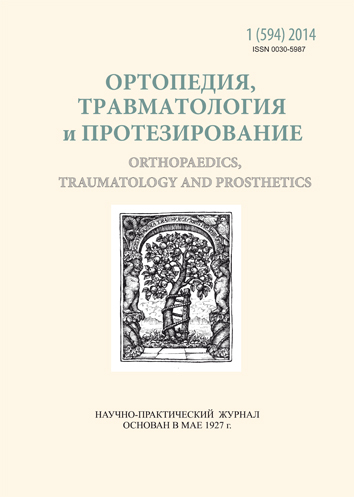Treatment of bone fragments nonunion after dyaphiseal fracture
DOI:
https://doi.org/10.15674/0030-59872014134-41Keywords:
ununion, diaphysis, treatment, osteoplasty, external fixation devicesAbstract
According to the Kharkiv interregional MSEC occurrences of nonunion fractures requiring additional surgical treatment ranges from 12.5 to 26 %. Treatment of such complication appeared requires weighed approach which might take into consideration its causes and clinical features in order to repeated surgery to be the last one.
Purpose: to evaluate clinical, radiological, morphological and mechanical features of the regenerate in patients with nonunion diaphyseal fractures, and to substantiate choice of their treatment and methods of stimulation of bone regeneration.
Methods: an experience of treatment of 73 patients with nonunion diaphyseal fractures of the extremities is presented. Among them 14 patients have had femur nonunion, 39 – shin bones nonunion, 14 – humerus nonunion, and 6 patients have had forearm bones nonunion. Terms passed after trauma or surgery amounted from 4 to 23 months. Nonunions was determined in 56 % patients after open reduction of bone fragments and internal osteosynthesis, in 33 % patients after extrafocal osteosynthesis with different apparatus of external fixation, and in 11 % patients after conservative treatment. Patients were subdivided into clinical groups based on the assessment of regenerate deformation: 1st — 16 patients with bone-cartilagenous healing; 2nd — 22 patients with free mobility of bone fragments sometimes combining with angular deformation, restriction of adjacent joint function, and considerable violation of the support function of the segment; 3rd — 35 patients with nonunion due to failure of internal fixation device.
Results: indications for using of closed compression osteosynthesis as well as of various types of plastic materials (small cancellous autologous bone grafts alone and in combination with platelet-rich plasma, autologous fibrin gel and other drugs containing fibrin) were clarified. Original external fixation devices allowing functional loading of the extremity were used for juxtapositioning of bone fragments. Positive outcomes were obtained in 95 % of cases.
Conclusions: deformation of soft-tissue regenerate in cases of nonunions was determined by its tissue structure. Forcible deformation is typical for bone-cartilagenous regenerate, and free one is typical for regenerate with prevalence of connective tissue. In case of dense bone-cartilagenous regenerate there were recommended creation of correct axial loading after closed elimination of its angular deformity by the external fixation device. It is a necessary to resect fibula fragment. Functional plaster dressing may be used in some cases. In case of nonunion with free type of deformation treatment has to be added with open surgery including decortication and removal of connective tissue from interfragmental area. Forming defect and subperiosteal area has to be filled with cancellous autologous bone grafts, autologous fibrin or fibrin-containing products. In case of nonunion diaphyseal fractures the use of the external fixation device is biomechanically substantiated. It allows dosage correction of the position of the fragments and thereby maintains axial vector of tension of the regenerate.
References
- Popsuyshapka A. K. Frequency of nonunion fragments with isolated diaphyseal fractures of long bones / A. K. Popsuyshapka, O. E. Uzhigova, V. A. Litvishko // Orthopedics, Traumatology and Prosthetics. — 2013. — № 1. — P. 39-43.
- . Popsuyshapka A. K. Treatment of nonunion of the tibia / A. K. Popsuyshapka , Samani Mutasa // Orthopedics , Traumatology and Prosthetics. — 1998. — № 2. — Р. 65-68.
- . Ryndenko V. G. Treatment slowed intergrows and ununited tibial fractures functional bandage / V. G. Ryndenko , A. K. Popsuyshapka // Orthopedics, Traumatology and Prosthetics. — 1986. — № 8. — P. 43-47.
- . Popsuyshapka A. K. Using rod apparatus for treatment for non-united fractures of the femur / A. K. Popsuyshapka , Z. Moniz // Orthopedics , Traumatology and Prosthetics. — 1999. — № 1. — Р. 59-62.
- Zubenko A. G. Optimization of reparative osteogenesis in fractures of the tibia (experimental-clinical study): аbstract dis. ... сandidate medical sciences / A. G. Zubenko. — Kyiv, 2011. — 19 p.
- Effect of platelet concentration in platelet-rich plasma on peri-implant bone regeneration / G. Weibrch, T. Hansen, W. Kleis [et al.] // Bone. — 2004. — Vol. 34. — P. 665–671.
- An opportunitu in perio-implantology: The PRF(in French) / J. Choukroun, F. Abba, C. Schoeffler , A. Vervelle // Implantodontie. — 2001. — Vol. 42. — P. 55–62.
- Campbell’s operative orthopardics / edited by A. H. Crenshaw. — 8th eg. — Mosby Gear Book, 1991. — 1288 р.
Downloads
How to Cite
Issue
Section
License
Copyright (c) 2014 Olexey Popsuishapka, Valeriy Litvishko, Vitaliy Grigoryev, Natalya Ashukina

This work is licensed under a Creative Commons Attribution 4.0 International License.
The authors retain the right of authorship of their manuscript and pass the journal the right of the first publication of this article, which automatically become available from the date of publication under the terms of Creative Commons Attribution License, which allows others to freely distribute the published manuscript with mandatory linking to authors of the original research and the first publication of this one in this journal.
Authors have the right to enter into a separate supplemental agreement on the additional non-exclusive distribution of manuscript in the form in which it was published by the journal (i.e. to put work in electronic storage of an institution or publish as a part of the book) while maintaining the reference to the first publication of the manuscript in this journal.
The editorial policy of the journal allows authors and encourages manuscript accommodation online (i.e. in storage of an institution or on the personal websites) as before submission of the manuscript to the editorial office, and during its editorial processing because it contributes to productive scientific discussion and positively affects the efficiency and dynamics of the published manuscript citation (see The Effect of Open Access).














